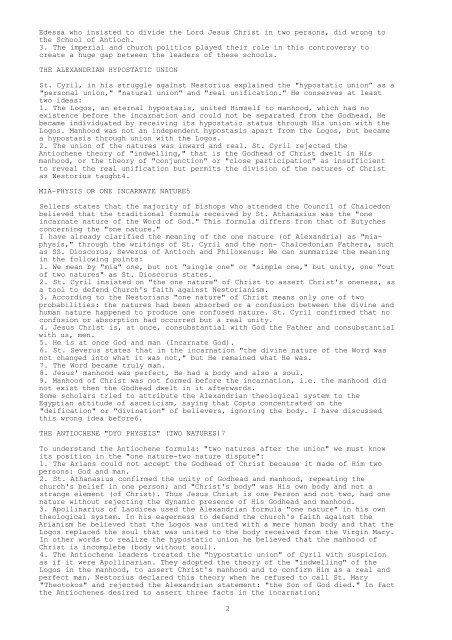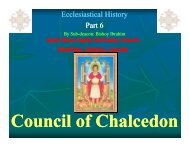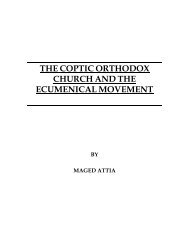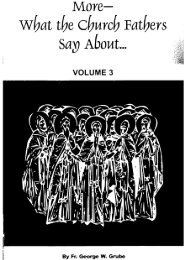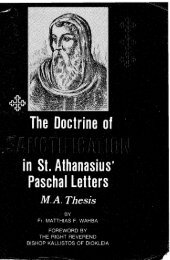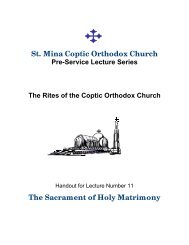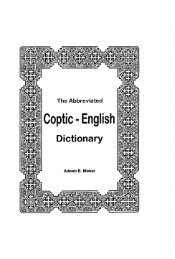Coptic interpretations of the Fourth Ecumenical Council - Saint Mina ...
Coptic interpretations of the Fourth Ecumenical Council - Saint Mina ...
Coptic interpretations of the Fourth Ecumenical Council - Saint Mina ...
You also want an ePaper? Increase the reach of your titles
YUMPU automatically turns print PDFs into web optimized ePapers that Google loves.
Edessa who insisted to divide <strong>the</strong> Lord Jesus Christ in two persons, did wrong to<br />
<strong>the</strong> School <strong>of</strong> Antioch.<br />
3. The imperial and church politics played <strong>the</strong>ir role in this controversy to<br />
create a huge gap between <strong>the</strong> leaders <strong>of</strong> <strong>the</strong>se schools.<br />
THE ALEXANDRIAN HYPOSTATIC UNION<br />
St. Cyril, in his struggle against Nestorius explained <strong>the</strong> "hypostatic union” as a<br />
"personal union," "natural union" and "real unification." He conserves at least<br />
two ideas:<br />
1. The Logos, an eternal hypostasis, united Himself to manhood, which had no<br />
existence before <strong>the</strong> incarnation and could not be separated from <strong>the</strong> Godhead. He<br />
became individuated by receiving its hypostatic status through His union with <strong>the</strong><br />
Logos. Manhood was not an independent hypostasis apart from <strong>the</strong> Logos, but became<br />
a hypostasis through union with <strong>the</strong> Logos.<br />
2. The union <strong>of</strong> <strong>the</strong> natures was inward and real. St. Cyril rejected <strong>the</strong><br />
Antiochene <strong>the</strong>ory <strong>of</strong> "indwelling," that is <strong>the</strong> Godhead <strong>of</strong> Christ dwelt in His<br />
manhood, or <strong>the</strong> <strong>the</strong>ory <strong>of</strong> "conjunction" or "close participation" as insufficient<br />
to reveal <strong>the</strong> real unification but permits <strong>the</strong> division <strong>of</strong> <strong>the</strong> natures <strong>of</strong> Christ<br />
as Nestorius taught4.<br />
MIA-PHYSIS OR ONE INCARNATE NATURE5<br />
Sellers states that <strong>the</strong> majority <strong>of</strong> bishops who attended <strong>the</strong> <strong>Council</strong> <strong>of</strong> Chalcedon<br />
believed that <strong>the</strong> traditional formula received by St. Athanasius was <strong>the</strong> "one<br />
incarnate nature <strong>of</strong> <strong>the</strong> Word <strong>of</strong> God." This formula differs from that <strong>of</strong> Eutyches<br />
concerning <strong>the</strong> "one nature."<br />
I have already clarified <strong>the</strong> meaning <strong>of</strong> <strong>the</strong> one nature (<strong>of</strong> Alexandria) as "mia-<br />
physis," through <strong>the</strong> writings <strong>of</strong> St. Cyril and <strong>the</strong> non- Chalcedonian Fa<strong>the</strong>rs, such<br />
as SS. Dioscorus, Severus <strong>of</strong> Antioch and Philoxenus: We can summarize <strong>the</strong> meaning<br />
in <strong>the</strong> following points:<br />
1. We mean by "mia" one, but not "single one" or "simple one," but unity, one "out<br />
<strong>of</strong> two natures" as St. Dioscorus states.<br />
2. St. Cyril insisted on "<strong>the</strong> one nature" <strong>of</strong> Christ to assert Christ's oneness, as<br />
a tool to defend Church's faith against Nestorianism.<br />
3. According to <strong>the</strong> Nestorians "one nature" <strong>of</strong> Christ means only one <strong>of</strong> two<br />
probabilities: <strong>the</strong> natures had been absorbed or a confusion between <strong>the</strong> divine and<br />
human nature happened to produce one confused nature. St. Cyril confirmed that no<br />
confusion or absorption had occurred but a real unity.<br />
4. Jesus Christ is, at once, consubstantial with God <strong>the</strong> Fa<strong>the</strong>r and consubstantial<br />
with us, men.<br />
5. He is at once God and man (Incarnate God).<br />
6. St. Severus states that in <strong>the</strong> incarnation "<strong>the</strong> divine nature <strong>of</strong> <strong>the</strong> Word was<br />
not changed into what it was not," but He remained what He was.<br />
7. The Word became truly man.<br />
8. Jesus' manhood was perfect, He had a body and also a soul.<br />
9. Manhood <strong>of</strong> Christ was not formed before <strong>the</strong> incarnation, i.e. <strong>the</strong> manhood did<br />
not exist <strong>the</strong>n <strong>the</strong> Godhead dwelt in it afterwards.<br />
Some scholars tried to attribute <strong>the</strong> Alexandrian <strong>the</strong>ological system to <strong>the</strong><br />
Egyptian attitude <strong>of</strong> asceticism, saying that Copts concentrated on <strong>the</strong><br />
"deification" or "divination" <strong>of</strong> believers, ignoring <strong>the</strong> body. I have discussed<br />
this wrong idea before6.<br />
THE ANTIOCHENE "DYO PHYSEIS" (TWO NATURES)7<br />
To understand <strong>the</strong> Antiochene formula: "two natures after <strong>the</strong> union" we must know<br />
its position in <strong>the</strong> "one nature-two nature dispute":<br />
1. The Arians could not accept <strong>the</strong> Godhead <strong>of</strong> Christ because it made <strong>of</strong> Him two<br />
persons: God and man.<br />
2. St. Athanasius confirmed <strong>the</strong> unity <strong>of</strong> Godhead and manhood, repeating <strong>the</strong><br />
church's belief in one person; and "Christ's body" was His own body and not a<br />
strange element (<strong>of</strong> Christ). Thus Jesus Christ is one Person and not two, had one<br />
nature without rejecting <strong>the</strong> dynamic presence <strong>of</strong> His Godhead and manhood.<br />
3. Apollinarius <strong>of</strong> Laodicea used <strong>the</strong> Alexandrian formula "one nature" in his own<br />
<strong>the</strong>ological system. In his eagerness to defend <strong>the</strong> church's faith against <strong>the</strong><br />
Arianism he believed that <strong>the</strong> Logos was united with a mere human body and that <strong>the</strong><br />
Logos replaced <strong>the</strong> soul that was united to <strong>the</strong> body received from <strong>the</strong> Virgin Mary.<br />
In o<strong>the</strong>r words to realize <strong>the</strong> hypostatic union he believed that <strong>the</strong> manhood <strong>of</strong><br />
Christ is incomplete (body without soul).<br />
4. The Antiochene leaders treated <strong>the</strong> "hypostatic union" <strong>of</strong> Cyril with suspicion<br />
as if it were Apollinarian. They adopted <strong>the</strong> <strong>the</strong>ory <strong>of</strong> <strong>the</strong> "indwelling" <strong>of</strong> <strong>the</strong><br />
Logos in <strong>the</strong> manhood, to assert Christ's manhood and to confirm Him as a real and<br />
perfect man. Nestorius declared this <strong>the</strong>ory when he refused to call St. Mary<br />
"Theotokos" and rejected <strong>the</strong> Alexandrian statement: "<strong>the</strong> Son <strong>of</strong> God died." In fact<br />
<strong>the</strong> Antiochenes desired to assert three facts in <strong>the</strong> incarnation:<br />
2


